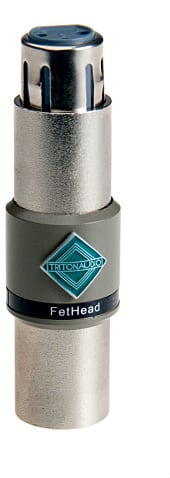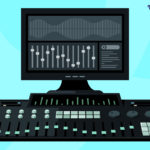Triton FetHead: a Podcasting Review
This is a guest review by Dan Redler, looking at the ever-popular Triton Fethead pre-amp.
My 
I’ve tried several microphones, including the popular Blue Yeti. But, even the Yeti had to go back because it picked up all the noise it could find. Out of frustration, I went back to ground zero and purchased a well-reviewed, semi-budget dynamic mic, the Audio-Technica AT 2005 USB.
Dynamic mics typically pick up less ambient sound than condensers, but they are less sensitive. Consequently, I found that I had to increase the gain on my mixer substantially. The result? You guessed it. The dynamic mic was now picking up much of the same ambient room noise I experienced with the condenser mics.
Searching for a solution somewhere in the universe called Google, I discovered the Triton Fethead. The Fethead is a microphone preamp handcrafted in the Netherlands.
Where would you use the Fethead?
The Triton Fethead is useful if you record:
- in an acoustically challenged room (high ceilings, hard surfaces)
- with any dynamic (or ribbon) microphone.
It doesn’t matter if it’s a budget mic, or a semi-budget mic like mine. Even if you use the Heil PR40 or the Shure SM7, you may find that this little marvel of a device will noticeably improve your recordings.
What type of recording setup does the Fethead suit?
Virtually any setup using a dynamic or ribbon microphone will benefit from the Triton FetHead.
The Triton Fethead needs phantom power. Dynamic and ribbon mics typically don’t. So, a mixer or other interface that has a phantom power generator is a must. The Fethead blocks the phantom power from entering the microphone, so it’s safe to use.
The Fethead plugs into your mic’s XLR connection, and just sits there at the end of your mic. It’s pretty unobtrusive once it’s installed. It just extends the length of your mic, and adds a tiny bit of weight. It works well with my shock mount and boom arm, and I’m confident that it will adapt to virtually any setup.
What are the pros and cons when using the Triton Fethead?
On the plus side:
- The Fethead boosts the mic gain by around 20-25 db. So, you can substantially turn down the gain on your mixer.
- You can record with more clarity and presence and much less room noise.
- The device fits any dynamic mic with an XLR connection.
On the minus side:
- The Fethead requires phantom power, so if you have a USB only mic, it won’t work.
- If you don’t have one in your kit, you’ll need a mixer or interface that generates phantom power. That will increase your cumulative out of pocket costs.
- The device itself is not cheap. But, it is affordable at approximately $100.00. The European price, as of this post, is Euro 69.95. Everyone’s budget is their own affair. Consider this purchase according to your needs, your budget and your podcasting activity.
What are the Triton FetHead’s vital statistics?
The Triton FetHead is a low-noise, high quality, in-line microphone preamplifier. It provides improved sound for Ribbon and Dynamic microphones. The electronics are housed in a robust metal chassis with a balanced 3-pole female XLR input and a balanced 3-pole male XLR output. It is rugged enough for use at home, in the studio or on tour.
How it works:
Attach the FetHead to a balanced mic cable and plug it straight into the microphone. You don’t need any extra cables. Switch on phantom power and enjoy clean gain!
Features:
- Ultra low-noise Class A JFet amplifier
- 27dB amplification (@3 KOhm load)
- Double single ended amplifier topology
- 4 matched jFets
- Shielded enclosure
- Z-in triton22k
- 24-48 v phantom power
The Triton FetHead is available in three versions:
- Fethead: A regular version for Ribbon and Dynamic microphones
(This is the model I use and reference in this review) - Fethead Phantom: A FetHead for Condenser microphones
- Fethead Filter: A FetHead with high-pass filter for Ribbon and Dynamic mics
5. Triton Fethead Sound Sample
I recorded 5 audio samples.
All recordings used the AT2005USB mic (in XLR mode) patched into an Allen & Heath Zed Sixty 10FX mixer. Mic and Main Mix levels were set at 0. Main Mix Output directly to Tascam DR40 recorder. The only variables were: a) the Mic Gain setting and b) Fethead vs no Fethead. I identified each recording accordingly. I did not clean up any of the tracks, nor did I use any postproduction.
1. No Fethead. Mixer Input Gain = Dial at midpoint (+30db)
2. No Fethead. Mixer Input Gain = Dial at 3/4 – (+50db)
3. With Fethead (and phantom power). Mixer Input Gain = Dial below midpoint – (+20db)
4. With Fethead (and phantom power). Mixer Input Gain = Dial 10 dB below midpoint
5. With Fethead (and phantom power). Mixer Input Gain = Dial 15 dB below midpoint
(Settings are not absolute. They are comparative based on mixer dial settings)
The tests confirmed, at least to me, that the Triton Fethead improved my recordings. In my opinion, there was more clarity and especially more presence in my voice. Using the Triton Fethead, I was able to reduce the gain on the mixer’s mic channel and the resulting background noise was significantly lower.
6. Summary
The Triton Fethead is a simple, innocuous device.
It looks like it isn’t doing anything. There are no visible bells, whistles, lights nor sounds. In fact, that’s the beauty of this little gem. It does one thing, and it does it well.
If you use a dynamic (or ribbon) mic, want to improve the quality of your podcast recordings, regardless of the pedigree of your mic, and want to take a proactive step towards taming a room with poor acoustics, then the Triton Fethead may be the small secret weapon you didn’t know you needed.
There are lots of ways to improve your podcast. Some involve big changes, and some are nearly invisible. If you want to learn more, consider joining us at Podcraft Academy. With our courses, downloadable resources, and weekly live Q & A sessions, you’ll be able to polish your podcast until it shines.

